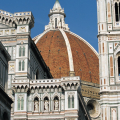CATTEDRALE SANTA MARIA DEL FIORE
The fourth largest cathedral in the world, Santa Maria del Fiore is crowned by Brunelleschi's revolutionary dome.
Both the cathedral and the baptistery are built on a large rectangular area formed by two ancient squares that are separate but connected. Santa Maria del Fiore is the fourth largest cathedral in the world, after St. Peter's in Rome, St. Paul's in London and the cathedral in Milan.
The current Duomo
is in fact the fourth reconstruction of the original temple. It was at the end of the 13th century that the City Council decided to replace the ancient cathedral of Santa Reparata (the martyred Virgin died in 250 AD at the age of 15) with a building worthy of the power of Florence. The first stage of this grandiose building, built on the right bank of the Arno, was undertaken by the Florentine architect Arnolfo di Cambio in 1296, and continued until 1434 by his successors according to a modified plan. Many architects, including Giotto, Andrea Orcagna, Talenti and Ghini, took part in this gigantic project, which lasted almost 140 years. Santa Maria del Fiore was consecrated on March 25, 1436 by Pope Eugenio IV. The cathedral is crowned by a revolutionary dome by Brunelleschi, built between 1420 and 1436, a true symbol of the Renaissance. The name of this huge place of worship, Santa Maria del Fiore (St. Mary of the Flower), refers to the Madonna of Florence, as well as the lily of the Florentine coat of arms. With a length of 153 meters, 23 meters longer than Notre-Dame-de-Paris, and a width of 38 meters, it defies the architectural limitations of the time.The exterior is entirely inlaid with green (from Prato), red (from Maremma) and white (from Carrara) marble, as are the baptistery and the campanile. The abundance of statues on the facade, built at the end of the 19th century, allowed Donatello, Nanni di Banco and Domenico Ghirlandaio to contribute, while the 44 stained glass windows were made by Lorenzo Ghiberti. On the south portal (campanile side) you can see a mosaic by Ghirlandaio, David and Dominic, and St. Matthew
, an unfinished work by Michelangelo. Only the lower part of the facade designed by Arnolfo di Cambio was completed during the Renaissance. Considered completely outdated, it was dismantled in 1587. It was not replaced until 1871, when the neo-Gothic project designed by Emilio de Fabris was adopted. When you enter the cathedral, you are struck by the size of the space and the sobriety of the decorations. The Latin cross plan, with an octagonal sanctuary at the crossing, is surrounded by three apses. The vault is above the choir and the high altar. The interior is decorated with frescoes by Paolo Uccello and Andrea del Castagno. The 44 stained glass windows represent saints from the Old and New Testaments (in the nave and transepts), as well as scenes from the life of Christ and Mary. The colored marble floor dates from 1526-1660 and has a distinctive plan, consisting of a three-aisled basilica body welded to a tri-lobed arch chevet that supports the huge dome. Executed in 1443 by Paolo Uccello, the colossal clock that surmounts the main portal is a liturgical clock that calculates the 24 hours of the day from the sunset of the previous day.Technical challenges, rivalries between geniuses and intrigues of power have marked the history of this absolute masterpiece of architecture.
Did you know? This review was written by our professional authors.
Members' reviews on CATTEDRALE SANTA MARIA DEL FIORE
The ratings and reviews below reflect the subjective opinions of members and not the opinion of The Little Witty.














Pour les amateurs de BD, la série "Médicis" reprend l'essor de Florence sous le règne des Médicis et permet d'anticiper ou de prolonger le voyage dans cette magnifique ville !